VITAC’s Greenwood Village office recently redesigned and renamed a number of its boardrooms, conference rooms, demo rooms, and training rooms to honor pioneers and noteworthy members of the deaf and hard-of-hearing community.
Each room contains a photo of that room’s namesake as well as a brief description of why we chose their representation. The rooms are used not only by VITAC staff, but also our visitors and clients.
We thought we’d share with you our choices:
Ludwig van Beethoven (Demo Room)
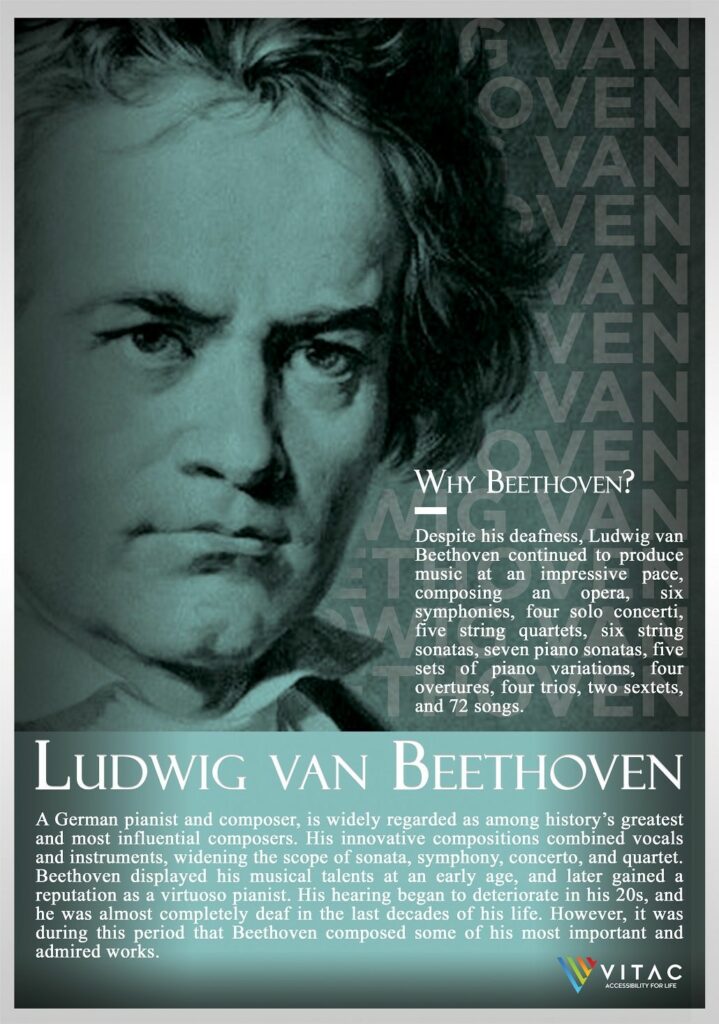 Ludwig van Beethoven, a German pianist and composer, is widely regarded as among history’s greatest and most influential composers. His innovative compositions combined vocals and instruments, widening the scope of sonata, symphony, concerto, and quartet. Beethoven displayed his musical talents at an early age, and later gained a reputation as a virtuoso pianist. His hearing began to deteriorate in his 20s, and he was almost completely deaf in the last decades of his life. However, it was during this period that Beethoven composed some of his most important and admired works.
Ludwig van Beethoven, a German pianist and composer, is widely regarded as among history’s greatest and most influential composers. His innovative compositions combined vocals and instruments, widening the scope of sonata, symphony, concerto, and quartet. Beethoven displayed his musical talents at an early age, and later gained a reputation as a virtuoso pianist. His hearing began to deteriorate in his 20s, and he was almost completely deaf in the last decades of his life. However, it was during this period that Beethoven composed some of his most important and admired works.
Why Beethoven?
Despite his deafness, Ludwig van Beethoven continued to produce music at an impressive pace, composing an opera, six symphonies, four solo concerti, five string quartets, six string sonatas, seven piano sonatas, five sets of piano variations, four overtures, four trios, two sextets, and 72 songs.
Alexander Graham Bell (Conference Room)
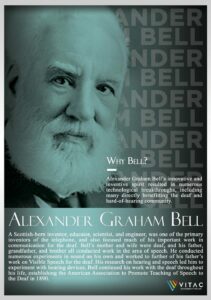 Alexander Graham Bell, a Scottish-born inventor, educator, scientist, and engineer, was one of the primary inventors of the telephone, and also focused much of his important work in communication for the deaf. Bell’s mother and wife were deaf, and his father, grandfather, and brother all conducted work in the area of speech. He conducted numerous experiments in sound on his own, and worked to further of his father’s work on Visible Speech for the deaf. His research on hearing and speech led him to experiment with hearing devices. Bell continued his work with the deaf throughout his life, establishing the American Association to Promote Teaching of Speech to the Deaf in 1890.
Alexander Graham Bell, a Scottish-born inventor, educator, scientist, and engineer, was one of the primary inventors of the telephone, and also focused much of his important work in communication for the deaf. Bell’s mother and wife were deaf, and his father, grandfather, and brother all conducted work in the area of speech. He conducted numerous experiments in sound on his own, and worked to further of his father’s work on Visible Speech for the deaf. His research on hearing and speech led him to experiment with hearing devices. Bell continued his work with the deaf throughout his life, establishing the American Association to Promote Teaching of Speech to the Deaf in 1890.
Why Bell?
Alexander Graham Bell’s innovative and inventive spirit resulted in numerous technological breakthroughs, including many directly benefiting the deaf and hard-of-hearing community.
Annie Jump Cannon (Conference Room)
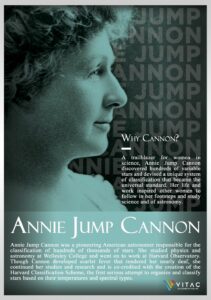 Annie Jump Cannon was a pioneering American astronomer responsible for the classification of hundreds of thousands of stars. She studied physics and astronomy at Wellesley College and went on to work at Harvard Observatory. Though Cannon developed scarlet fever that rendered her nearly deaf, she continued her studies and research and is co-credited with the creation of the Harvard Classification Scheme, the first serious attempt to organize and classify stars based on their temperatures and spectral types.
Annie Jump Cannon was a pioneering American astronomer responsible for the classification of hundreds of thousands of stars. She studied physics and astronomy at Wellesley College and went on to work at Harvard Observatory. Though Cannon developed scarlet fever that rendered her nearly deaf, she continued her studies and research and is co-credited with the creation of the Harvard Classification Scheme, the first serious attempt to organize and classify stars based on their temperatures and spectral types.
Why Cannon?
A trailblazer for women in science, Annie Jump Cannon discovered hundreds of variable stars and devised a unique system of classification that became the universal standard. Her life and work inspired other women to follow in her footsteps and study science and of astronomy.
Laurent Clerc (Conference Room)
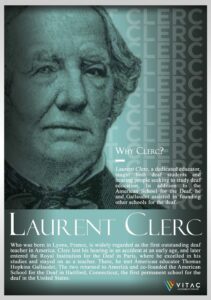 Laurent Clerc, who was born in Lyons, France, is widely regarded as the first outstanding deaf teacher in America. Clerc lost his hearing in an accident at an early age, and later entered the Royal Institution for the Deaf in Paris, where he excelled in his studies and stayed on as a teacher. There, he met American educator Thomas Hopkins Gallaudet. The two returned to America and co-founded the American School for the Deaf in Hartford, Connecticut, the first permanent school for the deaf in the United States.
Laurent Clerc, who was born in Lyons, France, is widely regarded as the first outstanding deaf teacher in America. Clerc lost his hearing in an accident at an early age, and later entered the Royal Institution for the Deaf in Paris, where he excelled in his studies and stayed on as a teacher. There, he met American educator Thomas Hopkins Gallaudet. The two returned to America and co-founded the American School for the Deaf in Hartford, Connecticut, the first permanent school for the deaf in the United States.
Why Clerc?
Laurent Clerc, a dedicated educator, taught both deaf students and hearing people seeking to study deaf education. In addition to the American School for the Deaf, he and Gallaudet assisted in founding other schools for the deaf.
Thomas Hopkins Gallaudet (Training Room)
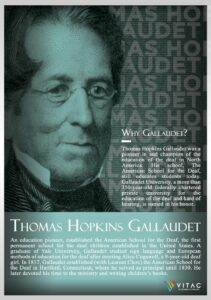 Thomas Hopkins Gallaudet, an education pioneer, established the American School for the Deaf, the first permanent school for the deaf children established in the United States. A graduate of Yale University, Gallaudet studied sign language and European methods of education for the deaf after meeting Alice Cogswell, a 9-year-old deaf girl. In 1817, Gallaudet established (with Laurent Clerc) the American School for the Deaf in Hartford, Connecticut, where he served as principal until 1830. He later devoted his time to the ministry and writing children’s books.
Thomas Hopkins Gallaudet, an education pioneer, established the American School for the Deaf, the first permanent school for the deaf children established in the United States. A graduate of Yale University, Gallaudet studied sign language and European methods of education for the deaf after meeting Alice Cogswell, a 9-year-old deaf girl. In 1817, Gallaudet established (with Laurent Clerc) the American School for the Deaf in Hartford, Connecticut, where he served as principal until 1830. He later devoted his time to the ministry and writing children’s books.
Why Gallaudet?
Thomas Hopkins Gallaudet was a pioneer in and champion of the education of the deaf in North America. His school, The American School for the Deaf, still educates students today. Gallaudet University, a more than 150-year-old federally chartered private university for the education of the deaf and hard of hearing, is named in his honor.
Helen Keller (Boardroom)
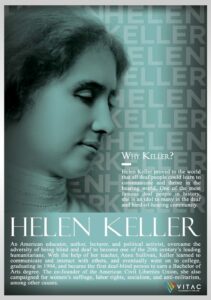 Helen Keller, an American educator, author, lecturer, and political activist, overcame the adversity of being blind and deaf to become one of the 20th century’s leading humanitarians. With the help of her teacher, Anne Sullivan, Keller learned to communicate and interact with others, and eventually went on to college, graduating in 1904, and became the first deaf-blind person to earn a Bachelor of Arts degree. The co-founder of the American Civil Liberties Union, she also campaigned for women’s suffrage, labor rights, socialism, and anti-militarism, among other causes.
Helen Keller, an American educator, author, lecturer, and political activist, overcame the adversity of being blind and deaf to become one of the 20th century’s leading humanitarians. With the help of her teacher, Anne Sullivan, Keller learned to communicate and interact with others, and eventually went on to college, graduating in 1904, and became the first deaf-blind person to earn a Bachelor of Arts degree. The co-founder of the American Civil Liberties Union, she also campaigned for women’s suffrage, labor rights, socialism, and anti-militarism, among other causes.
Why Keller?
Helen Keller proved to the world that all deaf people could learn to communicate and thrive in the hearing world. One of the most famous deaf people in history, she is an idol to many in the deaf and hard-of-hearing community.
Marlee Matlin (Conference Room)
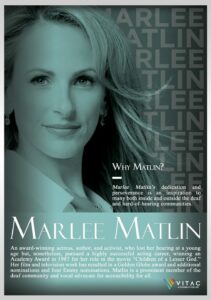 Marlee Matlin, an award-winning actress, author, and activist, lost her hearing at a young age but, nonetheless, pursued a highly successful acting career, winning an Academy Award in 1987 for her role in the movie “Children of a Lesser God.” Her film and television work has resulted in a Golden Globe award and additional nominations and four Emmy nominations. Matlin is a prominent member of the deaf community and vocal advocate for accessibility for all.
Marlee Matlin, an award-winning actress, author, and activist, lost her hearing at a young age but, nonetheless, pursued a highly successful acting career, winning an Academy Award in 1987 for her role in the movie “Children of a Lesser God.” Her film and television work has resulted in a Golden Globe award and additional nominations and four Emmy nominations. Matlin is a prominent member of the deaf community and vocal advocate for accessibility for all.
Why Matlin?
Marlee Matlin’s dedication and perseverance is an inspiration to many both inside and outside the deaf and hard-of-hearing communities.




